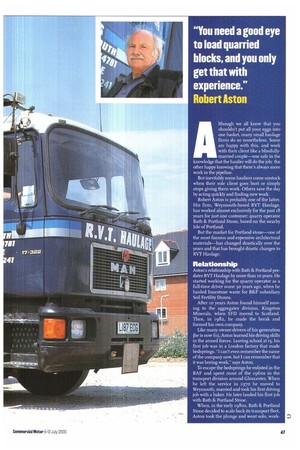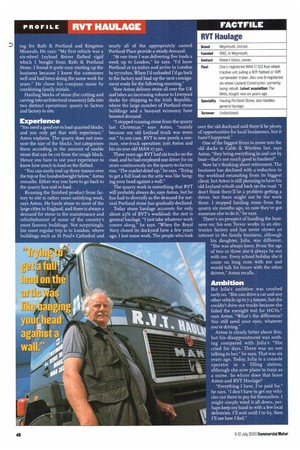"You need a good eye to load quarried blocks, and you only get that with experience."
Page 49

Page 50

If you've noticed an error in this article please click here to report it so we can fix it.
Robert Aston
Although we all know that you shouldn't put all your eggs into one basket, many small haulage firms do so nonetheless. Some are happy with this, and work with their client like a blissfullymarried couple—one safe in the knowledge that the haulier will do the job; the other happy knowing that there's always more work in the pipeline.
But inevitably some hauliers come unstuck when their sole client goes bust or simply stops giving them work. Others save the day by acting quickly and finding new work.
Robert Aston is probably one of the latter. His firm, Weymouth-based RVT Haulage, has worked almost exclusively for the past 18 years for just one customer: quarry operator Bath & Portland Stone, based on the nearby Isle of Portland.
But the market for Portland stone—one of the most famous and expensive architectural materials—has changed drastically over the years and that has brought drastic changes to RVT Haulage.
Relationship
Aston's relationship with Bath & Portland predates RVT Haulage by more than to years. He started working for the quarry operator as a full-time driver some 30 years ago. when he hauled limestone waste for B&P subsidiary Soil Fertility Dunns.
After to years Aston found himself moving to the aggregates division, Kingston Minerals, when SFD moved to Scotland. Then, in 1982, he made the break and formed his own company.
Like many owner-drivers of his generation (he is now 6t), Aston learned his driving skills in the armed forces. Leaving school at 15, his first job was in a London factory that made bedsprings. "I can't even remember the name of the company now, but I can remember that it was boring work," says Aston.
To escape the bedsprings he enlisted in the RAF and spent most of the 1960s in the transport division around Gloucester. When he left the service in 1970 he moved to Weymouth, married and took his first driving job with a baker. He later landed his first job with Bath & Portland Stone.
When, in the early 19808, Bath & Portland Stone decided to scale back its transport fleet, Aston took the plunge and went solo, work
ing for Bath SE Portland and Kingston Minerals. He says: "My first vehicle was a six-wheel Leyland Reiver flatbed rigid which I bought from Bath & Portland Stone. I found it quite easy starting up the business because I knew the customers well and had been doing the same work for years." He chose his company name by combining family initials.
Hauling blocks of stone (for cutting and carving into architectural masonry) falls into two distinct operations: quarry to factory and factory to site.
EXPOrkiliCID "You need a good eye to load quarried blocks, and you only get that with experience," Aston explains. The quarry does not measure the size of the blocks, but categorises them according to the amount of usable stone that can be cut from the rough block. Hence you have to use your experience to know how much to load on the flatbed.
"You can easily end up three tonnes over the top or five hundredweight below," Aston remarks. Either way you have to go back to the quarry face and re-load.
Running the finished product from factory to site is rather more satisfying work, says Aston. He hauls stone to most of the large cities in England, and there is always a demand for stone in the maintenance and refurbishment of some of the country's most famous buildings. Not surprisingly, his most regular trip is to London, where buildings such as St Paul's Cathedral and nearly all of the appropriately named Portland Place provide a steady demand.
"At one time I was delivering five loads a week up to London," he says. "I'd leave Portland at o3:oohrs and arrive in London by o7:oohrs. When I'd unloaded I'd go back to the factory and load up the next consignment ready for the following morning."
Now Aston delivers stone all over the UK and takes an increasing volume to Liverpool docks for shipping to the Irish Republic, where the large number of Portland stone buildings and a buoyant economy have boosted demand.
"I stopped running stone from the quarry last Christmas," says Aston, "mainly because my old Leyland truck was worn out." In any case, RVT is now purely a oneman, one-truck operation: just Aston and his six-year-old MAN 17.322.
Three years ago RVT had six trucks on the road, and he had employed one driver for six years continuously on the quarry-to-factory run. "The market dried up," he says. "Trying to get a full load on the artic was like banging your head against a wall."
The quarry work is something that RVT will probably always do, says Aston, but he has had to diversify as the demand for natural Portland stone has gradually declined.
Today stone haulage accounts for only about 25% of RVT's workload; the rest is general haulage. "I just take whatever work comes along," he says. "When the Royal Navy closed its dockyard here a few years ago, I lost some work. The people who took over the old dockyard said there'd be plenty of opportunities for local businesses, but it hasn't happened."
One of the biggest firms to move into the old docks is Cable & Wireless but, says Aston, "they bring everything in and out by boat—that's not much good to hauliers!".
Now he's thinking about retirement. The business has declined with a reduction in the workload emanating from its biggest client, but Aston is still planning to have his old Leyland rebuilt and back on the road. "I don't think there'll be a problem getting a driver, but there might not be the work there. I stopped hauling stone from the quarry six months ago, so now they've got someone else to do it," he says.
There's no prospect of handing the business on; his son Trevor works in an electronics factory and has never shown an interest in the family business, although his daughter, Julia, was different. "She was always keen. From the age of two or three she'd always be out with me. Every school holiday she'd come on long runs with me and would talk for hours with the other drivers," Aston recalls.
Ambition
But Julia's ambition was crushed early on. "She can drive a car and any other vehicle up to 7.5 tomes, but she couldn't drive our trucks because she failed the eyesight test for FIG Vs," says Aston. "What's the difference? You still need your eyes, whatever you're driving."
Aston is dearly bitter about this, but his disappointment was nothing compared with Julia's "She cried for days. There was no use talking to her," he says. That was six years ago. Today, Julia is a console operator in a filling station, although she now plans to train as a nurse. So where does that leave Aston and RVT Haulage?
"Everything I have, I've paid for," he says. "I don't have to get my vehicles out there to pay for themselves. might simply wind it all down, perSi haps keep my hand in with a few local deliveries. I'll wait until I'm 65, then I'll see howl feel."




















































































































